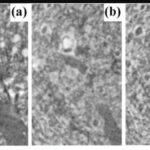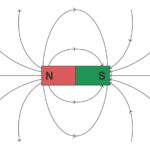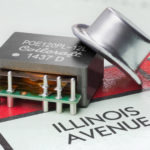These distinctions refer specifically to ferromagnetic and ferrimagnetic materials, not just hard and soft materials. There are super-soft, very-soft, soft, semi-hard, and hard magnetic material classifications based on the magnetic coercivity (HC) measured in ampere/meter (A/m) units or Oersteds (Oe).
This FAQ is focused primarily on soft, semi-hard, and hard magnetic materials. It begins with a brief overview of all the magnetic “hardness” types, then a deeper dive into the characteristics and applications of soft and hard materials. It closes with a brief look at some international standards related to magnetic materials.
HC measures the ability of a magnetic material to resist becoming demagnetized when exposed to an external magnetic field. Materials with high HC values are generally called “hard” and are suited for making permanent magnets or for use in magnetic recording media. Various soft magnetic materials are used for inductor and transformer cores, microwave devices, shielding, and recording heads. Often, all the variations on soft materials are lumped together as soft magnetic materials in contrast to hard materials. The detailed magnetic materials classifications are:
- Super soft – HC is below 10 A/m
- Very soft – HC from 10 to <100 A/m
- Soft – HC from 100 to <1000 A/m
- Semi-hard – HC from 1000 to <2000 A/m
- Hard – HC is 2000 A/m and greater
Using hysteresis loops
Magnetic hysteresis loops are useful for picturing some of the basic performance of hard and soft magnetic materials. A hysteresis loop plots magnetic field strength (H) on the x-axis and magnetic flux density (B) measured in Newton-meters per ampere (Nm/A), also called Teslas (T) on the y-axis. Movement on the magnetic hysteresis loops is counterclockwise. Two of the key points on a magnetic hysteresis curve are HC and BR. As noted above, HC is the coercivity. BR is the retentivity of the material (also called remanence, remanent magnetization, or residual magnetism) and measures the ability of the material to retain a magnetic field after an external source has been removed. HC is the quantity on the x-axis when B is zero, and BR is the quantity on the y-axis when H is zero. Figure 1 shows a family of hysteresis curves for various formulations of grain-oriented electrical steel, a soft magnetic material.
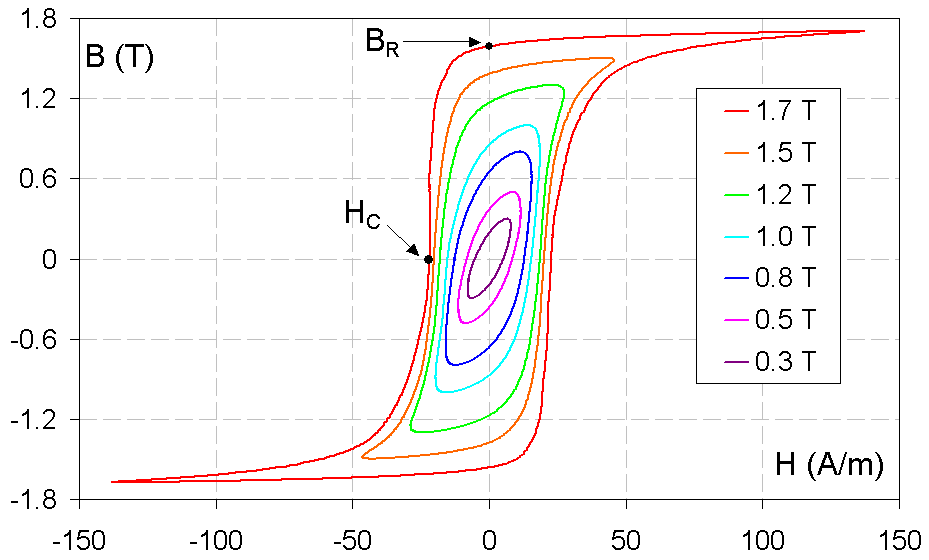
Electrical steel is usually manufactured in strips less than 2 mm thick that are used to make laminations stacked together to form the cores for low-frequency (like AC line frequency) transformers and the stators and rotors of low-frequency electric motors. Soft magnetic materials like electrical steel or various ferrites are easy to magnetize and demagnetize. They have low coercivity and high permeability and are used in electric energy conversion devices.
The area inside the hysteresis loop is proportional to the energy dissipated when magnetizing and demagnetizing a material. Soft materials like ferrites can achieve high values of BR and Bsat and dissipate relatively little energy through the hysteresis process, making them especially useful in applications like high-frequency transformer cores where the field is rapidly changing high to low and back again.
For example, permalloy and iron-silicon steel are two materials with similar retentivity but widely varying coercivities and permeabilities. Permalloy is a soft magnetic material consisting of about 20 percent Fe and 80 percent Ni and has a very high magnetic permeability (µ). In a hysteresis curve µ is illustrated by the curve’s maximum slope. On the other hand, iron-silicon steel is a hard magnetic material. HC for permalloy is about 0.05 Oe, 10x lower than that of the iron-silicon steel (Figure 2). The vastly different areas inside the hysteresis loops for the materials illustrate the enormous energy needed to magnetize and demagnetize iron-silicon steel compared to permalloy.
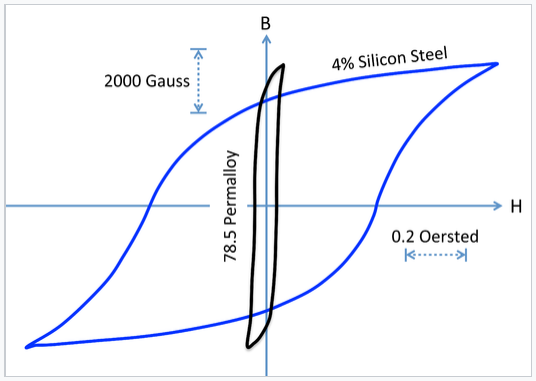
The difference between hard and soft magnetic materials is not quite that simple. Some materials, like metallic iron, can be either hard or soft, depending on various factors. In the case of iron, the crystal grain size is the critical factor. When the crystal grains have sub-micron dimensions, they are comparable in size to the magnetic domains, and the grain boundaries pin the domains. Domain wall pinning occurs at surfaces so that no more surface than is needed is created. Pinned domains require a stronger coercive magnetic field applied to realign the domains. When the iron is annealed, the size of the crystal grains increases and the magnetic domains can more easily realign when a magnetic field is applied. That decreases the coercive field, and the material becomes magnetically softer. Varying the crystal structure in materials like iron can result in various magnetic properties, from hard to soft (Figure 3).

Another slant on hysteresis
The slopes of hysteresis curves are different for soft and hard magnetic materials and directly reflect the associated magnetic properties. The slope of the hysteresis curve as it crosses the B (vertical) axis is very steep for soft magnetic materials and shallow for hard materials. That reflects that soft magnetic materials more quickly lose their magnetism as the external field is released, while hard materials have a harder “grip” on their magnetic fields and lose them more slowly. The slope for hard magnetic materials remains less steep until the applied field reaches a threshold; then, it plunges downward and continues with a steep slope as it passes through the coercivity value for that material. The steep slope for hard materials continues until saturation is nearly achieved when the slope quickly flattens. Finally, the hysteresis curve for a hard material is wider than the curve for a soft material because a hard material requires a larger magnetic field to become magnetized (Figure 4).
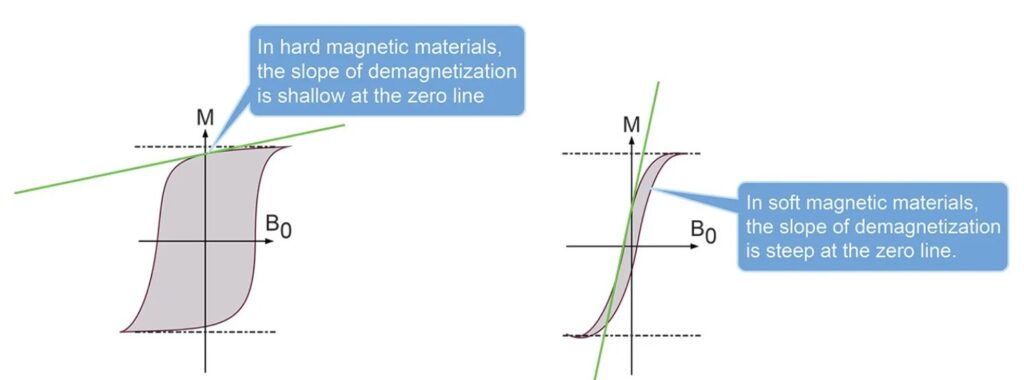
What’s special about neodymium?
Neodymium (Nd) magnets are the most widely used type of rare-earth magnet. It is a permanent magnet made from an alloy of neodymium, iron, and boron in the Nd2Fe14B tetragonal crystalline structure called NdFeB. The high strength of neodymium magnets is the result of several factors. For example, the material’s crystal structure preferentially magnetizes along a specific crystal axis but is very difficult to magnetize in other directions.
In addition, an Nd atom can have a large magnetic dipole moment since it has four unpaired electrons compared to an average of 3 unpaired electrons for iron. The unpaired electrons in a magnetic material align, so their spins are in the same direction, generating the magnetic field. That gives NdFeB magnets a high saturation magnetization of about 1.6 T and a remnant magnetization of about 1.3 T. That also results in the highest coercivity of any permanent magnetic material. The coercivity of NdFeB is 1.3 T compared with 0.07 T for alnico and 1.0 for samarium cobalt permanent magnets.
IEC and other magnetics standards
Several organizations publish standards related to magnetics; the most notable is the International Electrotechnical Commission (IEC). Other standards organizations include ASTM, Transformer Association, Motion Control & Motor Association (MCMA), and numerous national and industry-specific organizations.
In the IEC 60404 series of magnetics standards, there are over 20 subsections. For example, the first subsection is concerned with classifying magnetic materials.
IEC 60404-1 Ed. 3.0 b:2016, Magnetic Materials – Part 1: Classification, is available as a redline version (RLV) that shows all technical content changes compared to the previous edition. In this case, ‘magnetic materials’ include compounds and materials that exhibit ferromagnetic or ferrimagnetic properties. IEC 60404 classifies materials based on two main groups:
- Soft materials with a coercivity less than or equal to 1000 A/m
- Hard materials with a coercive greater than 1000 A/m
Examples of ASTM magnetics committees include:
- A06 – Main
- 01 – Test Methods
- 02 – Material Specifications
- 92 – Terminology and Definitions
- 93 – Precision and Bias
Summary
HC, or coercivity, is the key specification that determines the ‘hardness’ of a magnetic material. While the most common classifications are for ‘soft’ and “hard” magnetic materials, there’s a continuum from super soft to hard. Some materials, like iron, can be hard or soft depending on how they are processed. Another key differentiator of magnetic materials is the shape of their hysteresis curves. Hard materials have wide hysteresis curves, while soft materials have narrow and steep hysteresis curves. There are numerous national, industry-specific, and international standards for magnetic materials. The most notable is IEC 60404-1, which defines soft and hard materials.
References
Coercivity, Wikipedia
Hard and Soft Magnets, LibreTexts Chemistry
IEC 60404-1, International Electrotechnical Commission
Metrological aspects of an automated method for measuring electrophysical parameters of soft magnetic materials, Journal of Physics
Neodymium magnet, Wikipedia
Semi-Hard Magnets, Arnold Magnet Technologies
Understanding Remanence, Ideal Magnetic Solutions

